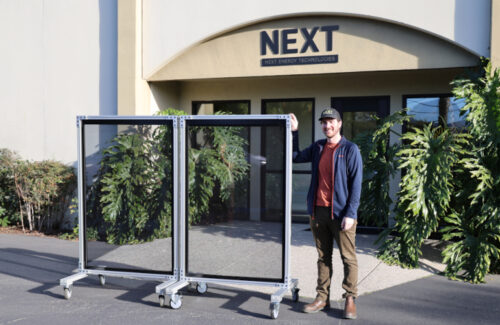Organic photovoltaic (OP) Technology Pioneer Next energy technologies has upgraded its pilot production line in California to produce 40 x 60. Laminated transparent Power-generating windows using its unique next OPT coating and production process. These 40 x 60 units are the biggest transparent up -on -windows that are produced all over the world, the company said.
 This pilot production marks an important step to enable the glass industry to produce full glass area glass for clean, solar energy-producing facades.
This pilot production marks an important step to enable the glass industry to produce full glass area glass for clean, solar energy-producing facades.
The following Overs coatings relate to the three major challenges for creating a scalable solution for the commercial glass industry: aesthetics, performance and production. The neutral gray coating, modeled to the most assumed color in North American commercial facades, is combined with power generation and in-line production to make a valuable solution for the glass industry.
“The combination of aesthetics of the highest quality, power generation and integration with the glass Supply Chain is a game changer in the push to designing the Net-Zero buildings,” said Andy Cohen, co-chairman of the architecture group Generous. “The middle of the last year we demonstrated the 27 x 35-in-in-in-in-Laste. Op -Vensters at our office in Los Angeles, and with this larger window format we have sustainable construction projects in our visor. “
The following is the preparation of demonstration installations with important American and European partners, while you focus on moving pilot to production scale and obtaining UL Safety and Performance Certification for Grid-Bonded Projects.
“This milestone is further evidence for an industry that is hungry for a solution that works our combination of OPD-Coatings and advanced production processing, can be scaled and can be used quickly,” said Daniel Emmett, co-founder, executive chairman and CEO from Next. “It is a proof that builds high trust in our path to 60 x 120-in-in. Commercial production. “
Next’s own transparent parenting coating can convert commercial windows into clean energy-generating facades, making buildings more sustainable and resilient and illuminate the grid. Not only can they produce power on site, absorb the windows and also convert infrared light, reducing the HVAC requirements of the building.
News item from next


